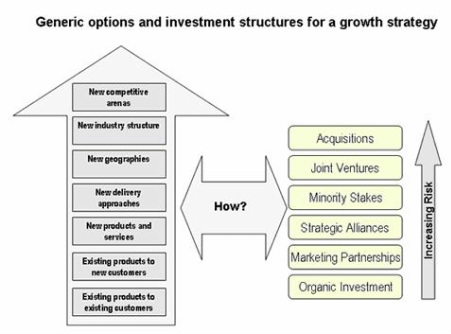MCKINSEY GROWTH PYRAMID
Introduction
This model is similar in some respects to the well-established Ansoff Model. However, it looks at growth strategy from a slightly different perspective. The McKinsey model argues that businesses should develop their growth strategies based on: • Operational skills • Privileged assets • Growth skills • Special relationships Growth can be achieved by looking at business opportunities along several dimensions, summarized in the diagram below: |
|
Operational skills are the “core competences” that a business has which can provide the foundation for a
growth strategy. For example, the business may have strong competencies in customer service; distribution,
technology.
well-established brand.
markets easier than for the competition.
The model outlines seven ways of achieving growth, which are summarised below:
1. EXISTING PRODUCTS TO EXISTING CUSTOMERS
The lowest-risk option; try to increase sales to the existing customer base; this is about increasing the
frequency of purchase and maintaining customer loyalty
2. EXISTING PRODUCTS TO NEW CUSTOMERS
Taking the existing customer base, the objective is to find entirely new products that these customers might
buy, or start to provide products that existing customers currently buy from competitors
3. NEW PRODUCTS AND SERVICES
A combination of Ansoff’s market development & diversification strategy – taking a risk by developing and
marketing new products. Some of these can be sold to existing customers – who may trust the business (and
its brands) to deliver; entirely new customers may need more persuasion.
4. NEW DELIVERY APPROACHES
This option focuses on the use of distribution channels as a possible source of growth. Are there ways in
which existing products and services can be sold via new or emerging channels, which might boost sales?
5. NEW GEOGRAPHIES
With this method, businesses are encouraged to consider new geographic areas into which to sell their
products. Geographical expansion is one of the most powerful options for growth – but also one of the most
difficult.
6. NEW INDUSTRY STRUCTURE
This option considers the possibility of acquiring troubled competitors or consolidating the industry
through a general acquisition programme
7. NEW COMPETITIVE ARENAS
This option requires a business to think about opportunities to integrate vertically or consider whether the
skills of the business could be used in other industries.
growth strategy. For example, the business may have strong competencies in customer service; distribution,
technology.
- Privileged assets are those assets held by the business that are hard to replicate by competitors. For example,
well-established brand.
- Growth skills are the skills that businesses need if they are to successfully “manage” a growth strategy.
- Special relationships are those that can open up new options. For example, the business may have specially
markets easier than for the competition.
The model outlines seven ways of achieving growth, which are summarised below:
1. EXISTING PRODUCTS TO EXISTING CUSTOMERS
The lowest-risk option; try to increase sales to the existing customer base; this is about increasing the
frequency of purchase and maintaining customer loyalty
2. EXISTING PRODUCTS TO NEW CUSTOMERS
Taking the existing customer base, the objective is to find entirely new products that these customers might
buy, or start to provide products that existing customers currently buy from competitors
3. NEW PRODUCTS AND SERVICES
A combination of Ansoff’s market development & diversification strategy – taking a risk by developing and
marketing new products. Some of these can be sold to existing customers – who may trust the business (and
its brands) to deliver; entirely new customers may need more persuasion.
4. NEW DELIVERY APPROACHES
This option focuses on the use of distribution channels as a possible source of growth. Are there ways in
which existing products and services can be sold via new or emerging channels, which might boost sales?
5. NEW GEOGRAPHIES
With this method, businesses are encouraged to consider new geographic areas into which to sell their
products. Geographical expansion is one of the most powerful options for growth – but also one of the most
difficult.
6. NEW INDUSTRY STRUCTURE
This option considers the possibility of acquiring troubled competitors or consolidating the industry
through a general acquisition programme
7. NEW COMPETITIVE ARENAS
This option requires a business to think about opportunities to integrate vertically or consider whether the
skills of the business could be used in other industries.

